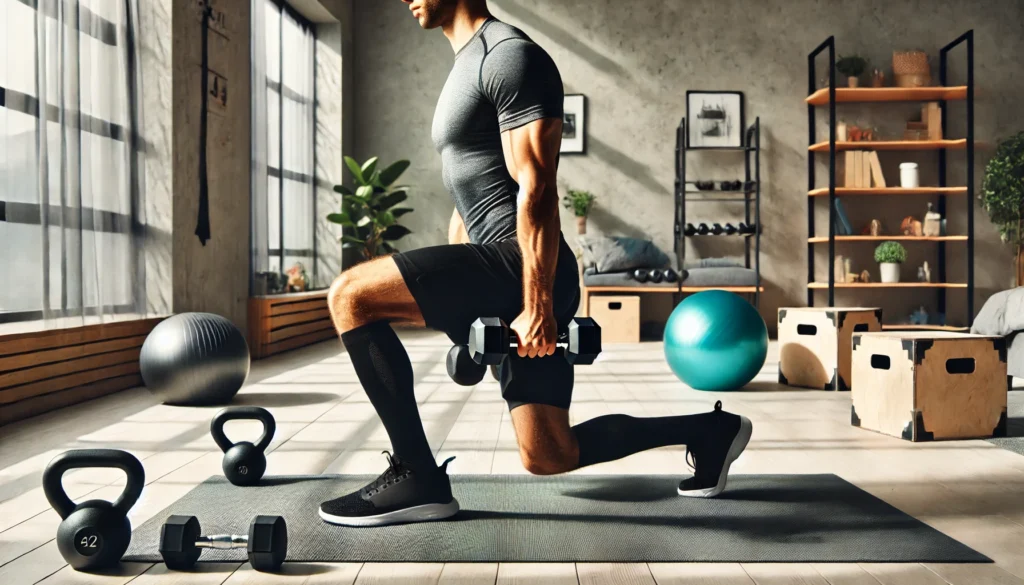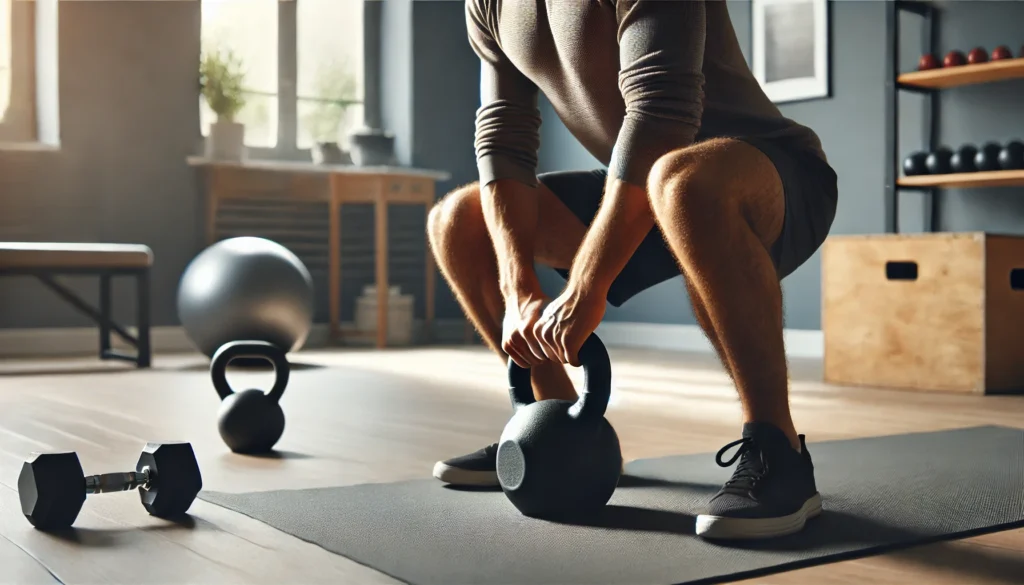Introduction: Maximizing Fitness Through Indoor Workouts
Indoor workouts provide an effective and convenient way to maintain physical health, build strength, and improve endurance without the need for a gym membership or specialized outdoor conditions. Whether due to weather constraints, limited access to fitness facilities, or a preference for privacy, indoor exercise options cater to a wide range of fitness levels and goals. A well-structured indoor workout plan can deliver comparable, if not superior, results to traditional outdoor or gym-based training. The key lies in leveraging the right combination of strength training, cardiovascular conditioning, and flexibility exercises to create a balanced fitness regimen. By implementing strategic variations and progressive overload, individuals can ensure long-term physical development and overall well-being.
You may also like: The Ultimate Bodyweight Workout Routine for Full-Body Strength and Performance
The Science Behind Indoor Workouts: Efficiency and Adaptability
Indoor workouts offer a unique advantage by allowing precise control over environmental factors, ensuring consistency and adaptability in training. Studies have shown that bodyweight exercises and resistance training performed indoors can elicit significant muscle hypertrophy, cardiovascular improvements, and metabolic benefits. Additionally, the ability to use various training modalities such as resistance bands, dumbbells, and kettlebells enhances muscle recruitment and neuromuscular efficiency. High-intensity interval training (HIIT) performed in an indoor setting has been demonstrated to improve VO2 max and anaerobic threshold, leading to superior endurance adaptations. The structured nature of indoor exercise also allows for targeted rehabilitation and mobility enhancement, making it an ideal choice for individuals recovering from injuries or managing chronic conditions.
Strength Training at Home: Building Muscle and Power
Indoor strength training can be highly effective for muscle hypertrophy, functional strength, and injury prevention. Exercises such as squats, lunges, push-ups, and planks target multiple muscle groups simultaneously, fostering efficient movement patterns. Resistance bands and free weights further enhance the efficacy of bodyweight exercises by adding external resistance, stimulating greater muscle fiber recruitment. Progressive overload principles can be applied by increasing repetitions, adjusting time under tension, or incorporating advanced movement variations. Compound movements such as deadlifts, overhead presses, and rows using kettlebells or dumbbells facilitate maximal muscle engagement while improving joint stability. A structured indoor strength training program ensures comprehensive muscular development and sustained physical performance.
Cardiovascular Fitness: Elevating Heart Rate Indoors
Cardiovascular conditioning remains an integral component of any fitness regimen, and indoor exercise provides numerous options to elevate heart rate and improve aerobic capacity. Jump rope routines, stair climbing, and treadmill sprints offer high-intensity cardiovascular challenges that mimic outdoor activities. HIIT sessions that combine bodyweight movements such as burpees, mountain climbers, and jumping lunges maximize caloric expenditure while enhancing endurance. Low-impact alternatives, including stationary cycling and rowing machine workouts, provide joint-friendly cardiovascular benefits suitable for individuals with mobility concerns. By structuring indoor cardio workouts with interval-based progression, individuals can optimize fat oxidation and cardiovascular efficiency. The adaptability of indoor cardio exercises ensures sustained engagement and progressive fitness improvements.

Functional Movement Training: Enhancing Mobility and Coordination
Functional fitness focuses on movement efficiency, flexibility, and coordination, all of which are critical for long-term health and injury prevention. Indoor workouts that emphasize mobility drills, balance exercises, and core stabilization improve proprioception and neuromuscular control. Yoga and Pilates sessions enhance flexibility, strengthen deep stabilizing muscles, and promote postural awareness. Dynamic warm-ups incorporating hip openers, shoulder mobility drills, and rotational movements prepare the body for more intense exercise while reducing the risk of strains and imbalances. Plyometric exercises such as box jumps and agility drills develop explosive power and reaction time, which are beneficial for athletes and active individuals. Integrating functional training into an indoor workout routine fosters greater movement efficiency and resilience against injuries.
The Role of Recovery in Indoor Exercise Programs
Optimal recovery strategies are essential to prevent overtraining and maximize the benefits of indoor workouts. Foam rolling and self-myofascial release techniques aid in reducing muscle tightness and improving circulation. Active recovery sessions incorporating light stretching, mobility drills, and low-intensity indoor workouts promote tissue repair while maintaining movement patterns. Adequate hydration, sleep, and nutrition support muscle recovery, hormonal balance, and overall physical performance. Periodizing training intensity and incorporating rest days ensures long-term progress while preventing burnout. A well-rounded indoor fitness plan prioritizes both exertion and recuperation to sustain peak physical condition.
Adapting Indoor Workouts for Different Fitness Levels
Indoor exercise routines can be modified to accommodate beginners, intermediate trainees, and advanced athletes. Beginners benefit from foundational movement patterns such as bodyweight squats, modified push-ups, and low-impact cardio variations. Intermediate individuals can introduce resistance training, circuit-style workouts, and moderate-intensity interval training to enhance muscular endurance and cardiovascular fitness. Advanced trainees can incorporate high-intensity plyometrics, weighted calisthenics, and complex movement patterns for increased physical challenge. The scalability of indoor workouts ensures continuous progression while accommodating individual capabilities and goals. A strategic approach to exercise modification enhances long-term adherence and performance gains.
Indoor Workouts for Specific Training Goals
Fat Loss and Metabolic Conditioning: High-intensity circuit training, jump rope sessions, and metabolic resistance training enhance caloric burn and post-exercise oxygen consumption. Muscle Hypertrophy and Strength Development: Progressive resistance training, eccentric loading, and time-under-tension techniques maximize muscle fiber recruitment and strength gains. Endurance Training: Extended-duration cardio, stair climbing, and interval-based treadmill workouts build stamina and aerobic efficiency. Rehabilitation and Mobility Enhancement: Low-impact exercises, isometric holds, and controlled movement drills facilitate joint stability and injury recovery. Athletic Performance: Sport-specific agility drills, plyometric training, and rotational exercises improve speed, power, and coordination. By aligning indoor workouts with specific objectives, individuals can tailor their training to meet diverse fitness aspirations effectively.
Overcoming Challenges of Indoor Workouts
Despite their numerous advantages, indoor workouts may present challenges such as limited space, equipment constraints, and motivation fluctuations. Solutions include utilizing bodyweight exercises, resistance bands, and adjustable dumbbells to maximize training efficiency within confined areas. Structuring engaging workout routines with varying intensities and movement patterns prevents monotony and sustains motivation. Virtual fitness classes, guided workout apps, and accountability partners foster adherence to indoor exercise programs. By addressing potential obstacles, individuals can maintain a consistent and effective indoor workout regimen.

Frequently Asked Questions (FAQ) on Effective Indoor Workouts
1. How can I make my indoor workouts as effective as outdoor training? Indoor workouts can be just as effective as outdoor training by incorporating resistance, cardio, and flexibility exercises that challenge different muscle groups. One way to maximize indoor exercise efficiency is to use interval training, such as high-intensity interval training (HIIT), which increases heart rate and improves cardiovascular endurance. Additionally, using resistance bands, dumbbells, or bodyweight movements ensures progressive overload and muscle development. Integrating functional movement patterns such as squats, lunges, and push-ups enhances overall strength and stability. Finally, ensuring variety in workout routines prevents plateaus and maintains long-term engagement in indoor exercise.
2. What are the best ways to stay motivated for indoor exercise? Staying motivated for indoor workouts requires creating a structured routine with clear fitness goals. Engaging in virtual workout challenges, tracking progress through fitness apps, and following online guided workouts can help maintain consistency. Incorporating music, podcasts, or fitness classes adds variety and excitement to each session. Setting up a dedicated indoor exercise space with proper equipment enhances commitment and reduces distractions. Additionally, scheduling workouts with friends or family through virtual platforms can provide accountability and motivation.
3. How can I modify indoor workouts for limited space? Limited space does not have to be a barrier to effective indoor exercise. Focusing on bodyweight movements such as lunges, squats, and push-ups requires minimal space while still offering strength-building benefits. Compact equipment like resistance bands and adjustable dumbbells can replace bulkier gym machines. Utilizing vertical movement strategies, such as standing overhead presses or jumping exercises, optimizes small workout spaces. Additionally, rearranging furniture or using walls and doorways for stability exercises can help maximize available space. Planning workouts that minimize lateral movement ensures an efficient routine within confined indoor environments.
4. Are indoor workouts sufficient for cardiovascular health? Yes, indoor exercise can significantly improve cardiovascular health when structured correctly. Exercises such as jump rope, stair climbing, and dynamic bodyweight movements like burpees and high knees elevate heart rate efficiently. Low-impact alternatives like indoor cycling, rowing, or step workouts provide joint-friendly cardio benefits. Incorporating progressive interval training enhances endurance and fat oxidation over time. Consistency in cardiovascular-focused indoor workouts helps improve heart health, reduce stress levels, and boost overall fitness.
5. How do I prevent injury while performing indoor workouts? To prevent injury during indoor exercise, it is essential to warm up properly with dynamic stretching and mobility exercises. Maintaining proper form and technique for each movement reduces strain on joints and muscles. Using non-slip mats, wearing appropriate footwear, and ensuring a clutter-free workout space minimizes the risk of accidents. Progressing gradually in intensity, rather than overloading too quickly, helps prevent muscle strains and overuse injuries. Finally, incorporating cooldown routines with static stretching and foam rolling supports muscle recovery and reduces post-workout soreness.
6. Can indoor workouts be customized for different fitness levels? Absolutely! Indoor workouts can be tailored to suit beginners, intermediate exercisers, and advanced athletes. Beginners can start with modified movements such as knee push-ups or assisted squats to build foundational strength. Intermediate individuals can incorporate resistance bands, free weights, and more complex movement patterns for greater challenge. Advanced exercisers can increase intensity through explosive plyometrics, heavier weights, or extended workout durations. The key is to adjust repetitions, resistance, and rest intervals according to fitness level and progression.
7. What are some effective indoor workouts for improving flexibility? Flexibility-focused indoor exercise routines often include yoga, Pilates, and dynamic stretching. Yoga sequences such as sun salutations and deep lunges enhance mobility and reduce stiffness. Foam rolling and self-myofascial release techniques help improve muscle elasticity and prevent tightness. Static stretching, performed post-workout, aids in elongating muscles and improving overall range of motion. Incorporating flexibility exercises into a regular fitness routine promotes better posture and reduces the risk of injuries during other indoor workouts.
8. How can I incorporate strength training into my indoor workouts? Strength training in an indoor setting can be accomplished with bodyweight exercises, resistance bands, and free weights. Compound movements such as squats, deadlifts, and overhead presses activate multiple muscle groups efficiently. Using time-under-tension techniques, such as slow eccentric movements, enhances muscle engagement even with lighter resistance. Circuit training that alternates between upper and lower body exercises ensures balanced muscle development. Progressive overload through increased repetitions, weight, or resistance ensures continuous improvement in strength.
9. What are the psychological benefits of indoor exercise? Engaging in regular indoor workouts offers substantial psychological benefits, including reduced stress and improved mental clarity. Exercise triggers endorphin release, enhancing mood and reducing symptoms of anxiety and depression. Structured indoor exercise routines provide a sense of accomplishment and boost self-discipline. Indoor fitness activities such as yoga and meditation-based movement improve mindfulness and emotional regulation. Additionally, participating in virtual workout communities fosters social connection and motivation.
10. How can I track progress with indoor workouts? Tracking progress in indoor exercise can be done through digital fitness apps, wearable trackers, or journaling workout performance. Monitoring metrics such as workout duration, intensity, and repetitions provides insight into fitness improvements. Taking periodic progress photos or recording personal bests in strength exercises helps assess physical changes over time. Setting short-term and long-term fitness goals ensures continuous motivation and consistency. By regularly evaluating progress, individuals can make necessary adjustments to their indoor workout routines for optimal results.

Conclusion: Elevating Fitness Through Indoor Training
Indoor workouts offer a dynamic and adaptable approach to achieving strength, endurance, and overall physical fitness. Whether targeting muscular hypertrophy, cardiovascular improvements, or functional movement efficiency, a structured indoor exercise program delivers comprehensive health benefits. By incorporating strength training, high-intensity cardio, functional mobility work, and strategic recovery practices, individuals can optimize their fitness journey within indoor settings. The versatility and accessibility of indoor exercise make it a sustainable and impactful component of a lifelong health and wellness routine.
fitness training, home workouts, endurance exercises, strength training, HIIT workouts, indoor cardio, functional movement, weight training, mobility exercises, recovery strategies, athletic conditioning, flexibility training, home gym, low-impact workouts, workout modifications, performance optimization, metabolic conditioning, rehabilitation exercises, core strengthening, exercise programming.
Further Reading:
10-Indoor Cardio Exercises: A Comprehensive Guide to Staying Fit Indoors
Indoor Exercise 101: Your Guide to Effective Workouts at Home
The Guide to the Best Indoor Workouts
Important Note: The content provided by HealthXWire is for informational purposes only and should not be construed as medical advice, diagnosis, or treatment. While we strive for accuracy, the information presented on this site may not reflect the most current research or medical guidelines. Always seek the advice of your physician or other qualified health provider with any questions you may have regarding a medical condition. HealthXWire does not endorse, recommend, or guarantee the efficacy of any products, services, or treatments mentioned on this site. Users should not disregard professional medical advice or delay seeking it because of something they have read on HealthXWire. HealthXWire is not liable for any damages, loss, or injury arising from reliance on the information provided herein.



